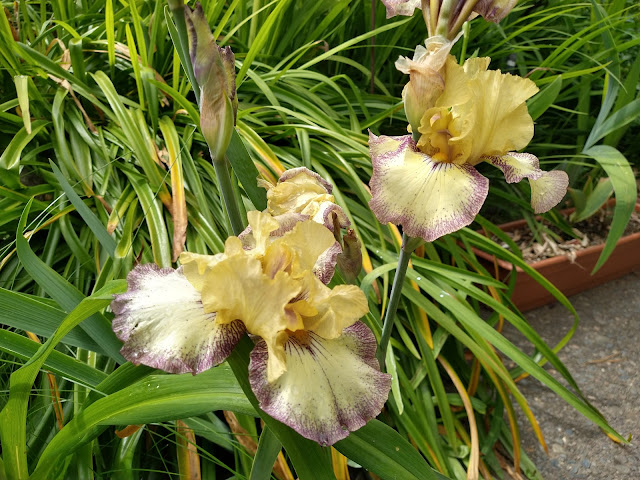
See hundreds of irises in bloom; take some home, too

|
|
This beauty is a Tennessee Gentleman iris, purchased several years ago at the
Sacramento Iris Show. See many varieties at the show and sale this weekend.
(Photo: Debbie Arrington)
|
One of Sacramento’s favorite spring flowers gets its turn in the spotlight this weekend when the Sacramento Iris Society hosts its annual show and sale.
Shepard Garden and Arts Center in McKinley Park will be overflowing with bearded irises and other species in their colorful glory. With the theme “National Parks,” the iris show will be open to the public from 1 to 5 p.m. Saturday, April 23, and 10 a.m. to 3 p.m. Sunday, April 24.
This will be a judged show with many different varieties and kinds of irises vying for awards. It’s a great opportunity to learn about the many different color combinations and how to better identify varieties.
Take some home, too! The club will offer potted irises for sale with plants ready to transplant now.
Bearded iris, the most common perennial iris, is a water-wise wonder that thrives in Sacramento. After showy spring blooms, bearded irises need little summer irrigation – just once a week or twice a month. The plant dies back in August before sprouting new growth in late fall or winter.
Originally hybridized in Germany, bearded irises (also known as flags) now include more than 60,000 named cultivars and come in every color from pure white to black with countless shades in between. The most common colors are blues and purples, closest to the iris family’s native hues.
Admission and parking are free. Shepard Center is located at 3330 McKinley Blvd., Sacramento.
Details and directions: www.sgaac.org or https://sacramentoirissocietydotcom.wordpress.com/ .
Comments
0 comments have been posted.Sacramento Digs Gardening to your inbox.
Food in My Back Yard Series
May 6: Maintain soil moisture with mulch for garden success
April 29: What's (already) wrong with my tomato plants?
April 22: Should you stock up on fertilizer? (Yes!)
April 15: Grow culinary herbs in containers
April 8: When to plant summer vegetables
April 1: Don't be fooled by these garden myths
March 25: Fertilizer tips: How to 'feed' your vegetables for healthy growth
March 18: Time to give vegetable seedlings some more space
March 11: Ways to win the fight against weeds
March 4: Potatoes from the garden
Feb. 25: Plant a fruit tree now -- for later
Feb. 18: How to squeeze more food into less space
Feb. 11: When to plant? Consider staggering your transplants
Feb. 4: Starting in seed starting
Sites We Like
Garden Checklist for week of May 4
Enjoy this spring weather – and get gardening!
* Plant, plant, plant! It’s prime planting season in the Sacramento area. Time to set out those tomato transplants along with peppers and eggplants. Pinch off any flowers on new transplants to make them concentrate on establishing roots instead of setting premature fruit.
* Direct-seed melons, cucumbers, summer squash, corn, radishes, pumpkins and annual herbs such as basil.
* Harvest cabbage, lettuce, peas and green onions.
* In the flower garden, direct-seed sunflowers, cosmos, salvia, zinnias, marigolds, celosia and asters. (You also can transplant seedlings for many of the same flowers.)
* Plant dahlia tubers. Other perennials to set out include verbena, coreopsis, coneflower and astilbe.
* Transplant petunias, marigolds and perennial flowers such as astilbe, columbine, coneflowers, coreopsis, dahlias, rudbeckia and verbena.
* Keep an eye out for slugs, snails, earwigs and aphids that want to dine on tender new growth.
* Feed summer bloomers with a balanced fertilizer.
* For continued bloom, cut off spent flowers on roses as well as other flowering plants.
* Add mulch to the garden to maintain moisture. Mulch also cuts down on weeds. But don’t let it mound around the stems or trunks of trees or shrubs. Leave about a 6-inch to 1-foot circle to avoid crown rot or other problems.